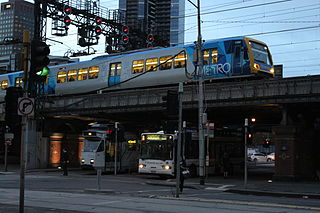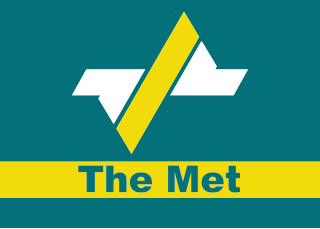
The Yarra River or historically, the Yarra Yarra River, is a perennial river in south-central Victoria, Australia.

Docklands, also known as Melbourne Docklands, is an inner-city suburb in Melbourne, Victoria, Australia, 2 km (1.2 mi) west of Melbourne's Central Business District, located within the City of Melbourne local government area. Docklands recorded a population of 15,495 at the 2021 census.

The Port of Melbourne is the largest port for containerised and general cargo in Australia. It is located in Melbourne, Victoria, and covers an area at the mouth of the Yarra River, downstream of Bolte Bridge, which is at the head of Port Phillip, as well as several piers on the bay itself. Since 1 July 2003, the Port of Melbourne has been managed by the Port of Melbourne Corporation, a statutory corporation created by the State of Victoria.

Transport in Melbourne, the state capital of Victoria, Australia, consists of several interlinking modes. Melbourne is a hub for intercity, intracity and regional travel. Road-based transport accounts for most trips across many parts of the city, facilitated by Australia's largest freeway network. Public transport, including the world's largest tram network, trains and buses, also forms a key part of the transport system. Other dominant modes include walking, cycling and commercial-passenger vehicle services such as taxis.

Coode Island is a former island at the convergence of the Yarra and Maribyrnong Rivers, 4 km west of central Melbourne, Australia. The island was formed by the excavation of the Coode Canal in 1887, and became connected to the mainland in the 1930s. Today the low-lying land is part of the Port of Melbourne, and is used as the site of Swanson and Appleton Docks and their associated container storage and rail yards, as well as a number of chemical storage facilities.

The Public Transport Corporation (PTC) was a Victoria State Government owned statutory authority formed under the Transport Act 1983 which operated passenger and freight trains, trams and bus services.

VicTrack, trading as the Victorian Rail Track Corporation, is a Victorian Government state-owned enterprise which owns all railway and tram lines, associated rail lands and other rail-related infrastructure in the state of Victoria, Australia, with the exception of the Emerald Tourist Railway Board's heritage Puffing Billy Railway.

The rail network of Melbourne, Australia, has a significant number of railway lines and yards serving freight traffic. Rail transport in Victoria is heavily focused on Melbourne, and, as a consequence, much of the state's rail freight passes through the metropolitan network.

Port Botany is a deepwater seaport located in Botany Bay in Sydney, Australia. The port is dominated by trade in containerised manufactured products and, to a lesser extent, bulk liquid imports including petroleum and natural gas. It is one of Australia's largest container ports and is administered by NSW Ports which entered into a 99-year lease agreement with the Port Authority of New South Wales in May 2013.
Transport law is the area of law dealing with transport. The laws can apply very broadly at a transport system level or more narrowly to transport things or activities within that system such as vehicles, things and behaviours. Transport law is generally found in two main areas:

The Transport Integration Act 2010 is a law enacted by the Parliament of the State of Victoria, Australia. The Act is the prime transport statute in Victoria, having replaced major parts of the Transport Act 1983, which was renamed as the Transport Act 1983.

The Department of Transport (DOT) was the government agency responsible for the coordination, integration and regulation of the transport system in the State of Victoria, Australia. The department generated planning, policy, and legislation for transport in Victoria. As a result, the department drove the integration of Victoria's transport land and water transport systems and the delivery of public transport, road and port services and associated activities across the State. The department's stated mission was "Building a safer, fairer and greener transport system for all Victorians to create a more prosperous and connected community."

The Director of Public Transport was the head of the Public Transport Division (PTD) of the Victorian Department of Transport. PTD was the government agency responsible for promoting, providing, coordinating and regulating public transport in the state of Victoria, Australia between August 1999 and June 2013. The Director of Public Transport was created as a statutory office supported by staff of the Department of Transport.
The Chief Investigator, Transport Safety is the independent Government agency responsible for investigation of safety-related trends and incidents in the rail, bus and marine industries in the State of Victoria, Australia.
Public Transport Victoria (PTV) is the statutory agency and brand name for public transport in the Australian state of Victoria. It was the trading name of the Public Transport Development Authority (PTDA), a now-defunct statutory authority in Victoria, responsible for providing, coordinating, and promoting public transport.
The Port of Hastings Development Authority is an authority of the Government of Victoria, Australia. The authority is responsible for the development and management of the port of Hastings located in Western Port Bay approximately 72 kilometres to the south east of Melbourne. The port is expected to be developed by the authority as a major new container port in competition with the Port of Melbourne, Australia's busiest container port.
The Melbourne Harbor Trust was established in 1877 to improve and operate port facilities for the growing city of Melbourne. It was superseded by the Port of Melbourne Authority in 1978 and later by the Port of Melbourne Corporation.

Victoria Dock is a large excavated harbour basin located off Footscray Road and Docklands Highway, Docklands, in Melbourne. It was constructed between 1887 and 1892, under the supervision of Melbourne Harbor Trust engineer Joseph Brady, to modified designs of British engineer Sir John Coode.

Swanson Dock is an international shipping facility in Melbourne, Victoria, Australia. It was constructed between 1966 and 1972 by the Melbourne Harbor Trust, leading off the north bank of the Yarra River, to alleviate congestion in the port and provide the first container shipping terminal in Melbourne. It is located about 2 km downstream from the Melbourne CBD and was named after Victor Swanson, chairman of the Melbourne Harbor Trust from 1960 to 1972.

The Victorian Regional Channels Authority (VRCA) is the channel management authority of the Victorian Government for the Port of Geelong, the Port of Portland, the Port of Hastings, and 13 other regional ports.















